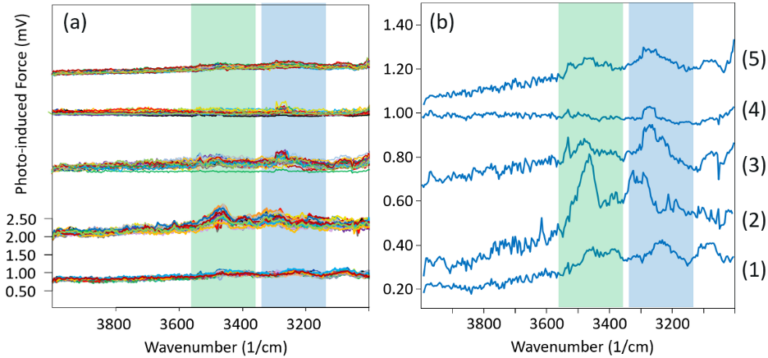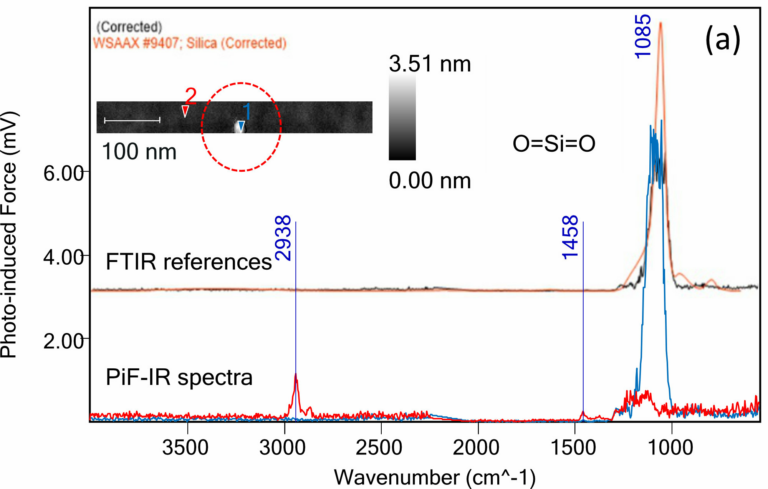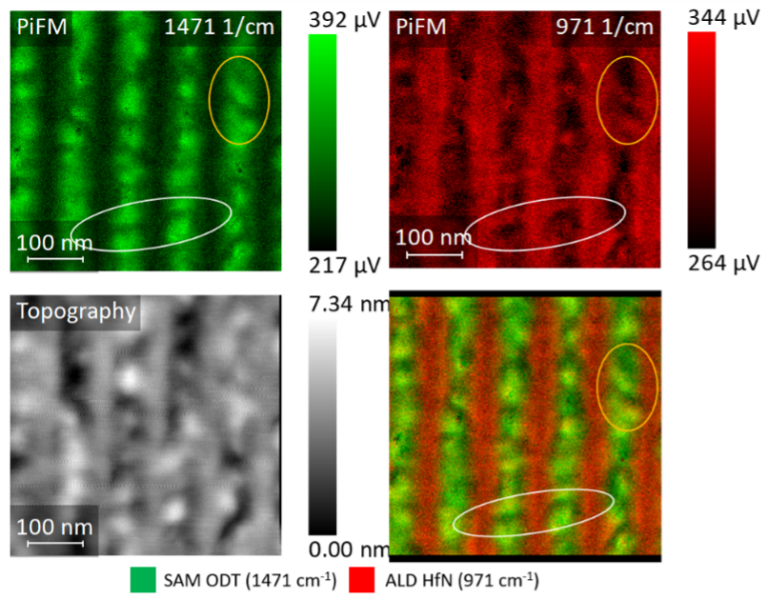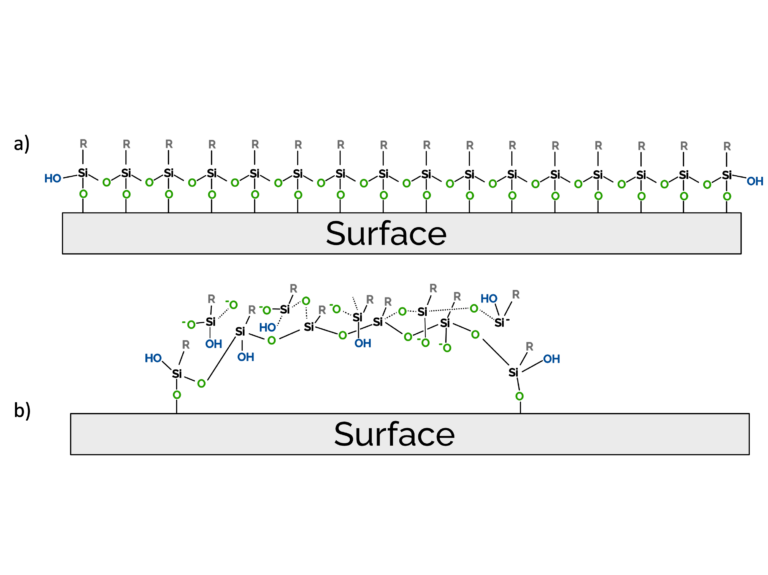Stay on top!
Get helpful articles and special offers once a month.
Get helpful articles and special offers once a month.
Our most advanced system with new automated features


三维驱动抛物面镜将激发光聚焦于探针侧面,适用于任意波长光源。
我们的悬臂梁对准芯片确保在更换悬臂梁期间,原子力显微镜(AFM)反馈系统与近场激光器的光学对准始终保持稳定。


我们的电动载物台具备6毫米行程与光学编码器,实现精密控制。原子力显微镜(AFM)扫描器中的电容传感器确保线性扫描精度达约100皮米均方根值。
无伪影快速样品成像:我们的双Z压电扫描器系统提供12微米垂直范围的大行程精准扫描。


探头与扫描器均采用因瓦合金制造,以实现最佳热稳定性。
我们的低剖面原子力显微镜探头支持使用高数值孔径的上置物镜,提供卓越的样品光学视野。该探头还配备最稳定的安装结构,以实现低漂移与声学稳定性。
纳米精度独立扫描可实现激发光源焦点在三维空间移动。


我们的可选环境/真空罩支持对整个显微镜环境进行定制。可在部分气压下使用任何气体工作、抽真空或控制湿度。
Vista One可安装于任意位置,我们的隔音罩、主动隔振台与外部线缆框架组合确保原子力显微镜(AFM)针尖保持静默。†
我们的隔音腔配备温控单元,使整个系统稳定在±0.1ºC范围内。*


Vista One是我们设计的原始光诱导力显微镜(PiF),可处理任何光学实验。它同时支持散射式近场光学显微镜(sSNOM)、共聚焦拉曼以及多种定制实验方案。
我们使用ThorLabs等供应商的标准光学元件。这意味着您无需受限于专有系统,且Vista One本质上具备无限可配置性。
*这些功能需搭配可选配件使用。
†基于典型实验室环境假设。任何原子力显微镜(AFM)在安静房间及稳定台面上性能最佳,因此实际结果因具体环境而异。
“我们很荣幸首批获得Molecular Vista的VistaScope设备。过去几年中,我们使用VistaScope进行飞秒激光脉冲的光诱导力显微镜(PiFM)测量。尽管此类实验本极具挑战性,但VistaScope使其变得异常简便。Molecular Vista在扫描头设计上表现卓越,可相对轻松地实现光路与针尖-样品结的耦合。该系统稳定性高,能轻松配置附加光学元件,并由直观多功能图形用户界面控制。设备安装后我们立即获得了精彩的PiFM数据,并持续每日使用该系统。我们强烈推荐VistaScope给所有致力于光学照明与先进扫描探针实验结合的研究者!”

显微镜: Vista One框架
隔振系统: 主动隔振台与温控声学隔离罩
激光器: 量子级联激光器(QCL)可选配置
多路复用器: 中型配置
倒置光学系统: 可选功能
附加模块(可选): 环境/湿度/真空控制系统、加热样品台、偏振切换器、干燥空气过滤系统、开尔文探针力显微镜(KPFM)、导电原子力显微镜(cAFM)、压电力显微镜(PFM)、力-体积映射、光谱仪、光子计数器(SP-APD)、散射式近场光学显微镜(s-SNOM)模块
Vista One红外系统完整配置
附加项:
Vista One红外系统完整配置
附加项:
显微镜: Vista One 框架
隔振系统: 主动隔振台与温控声学隔离罩
激光器: 用户自备
多路复用器: 可选配置
附加模块: 可选功能
Body Material: Invar for excellent thermal stability
Body Profile: 12 mm thick to allow short working distance top objective lens
AC Detector Noise: <50 fm/root Hz above 100 KHz
Detector Bandwidth: 6 MHz
Cantilever Deflection Sensor Laser: 904 nm with finely adjustable beam steering and focus
Manual Translation Stage: 3mm movement in X and Y for coarse tip alignment to focus point of optional bottom objective lens
Fast-Z Module: 1 um z-piezo on cantilever mount serves as the Fast-Z element of high-speed Dual-Z feedback system
Operational Environment: Ambient air, optional open liquid cell, or vacuum/partial pressure with optional environmental chamber cover
Excitation Optics: Broadband (400 nm – 20 um) integrated parabolic mirror with 3D piezo-motor stage for tip-sample illumination for PiFM and reflection-mode s-SNOM
Body Material: Invar for excellent thermal stability
TF Operation: Tapping-mode
Manual Translation Stage: 3 mm movement in X and Y for coarse tip alignment to external laser or focus point of bottom objective lens (for tip-enhanced spectroscopy)
Integrated Tip Scanner: X-Y flexure scanner built into head with 12 um x 12 um range for scanning the tuning fork
Fast-Z Module: 1 um z-piezo on cantilever mount serves as the Fast-Z element of high speed Dual-Z feedback system
Versatile frame architecture provides for multiple optical pathways to the tip-sample interface.
Inverted Objective Lens (optional): 100X 1.4NA Oil immersion lens or 60X 0.9A conventional lens forms the basis of a custom-designed inverted optical microscope for bottom viewing and illumination of the tip-sample interface. Optional broadband reflective lens available for wideband IR illumination.
Tip Alignment Mechanism: Piezo-driven XYZ stage (12 um for XY and 100 um for Z) for the inverted objective lens for precise alignment of the focus spot onto the tip
Top Objective Lens: 20X, 0.42NA 20 mm working distance standard; shorter working distance (down to 13 mm) also supported for higher NA options
Top Objective Lens Focus: Motorized with stored focus position for fast return after tip or sample change
Illumination: Software controlled LED for top-down bright field illumination; optional dark-field option available
CCD Camera: Concurrent top and inverted views ; digital zoom, pan, and capture
Tip-Sample Approach: Automated engagement
Sample Stage: Motorized precision stage with 6 mm x 6 mm travel range
Maximum Sample Size: 25 mm x 25 mm x 5 mm
System Noise: <90 pm RMS (dependent on environment)
Optical Configuration: Multiple optical pathways to bottom objective and side parabolic mirror provided; pathways are based on industry standard 1” cage system to allow user customization and expansion.
Sample Scanner: XYZ flexure stage scanner with 80 um x 80 um x 15 um scanning range (closed loop); Z sample scanner serves as the slow Z component of high speed Dual-Z feedback system. Built-in capacitive sensors provide closed-loop scanning control for X and Y for superb linearity and accuracy; optional Z capacitive sensor available.
Scanner Material: Invar for excellent thermal stability
Scanner Sensor Noise: 0.15 nm RMS for X and Y with 0.08 nm RMS achievable with software controlled reduced scan range (20 um x 20 um)
FPGA-based control electronics has a section dedicated for high speed scanning probe microscopy.
Sampling Rate: >500 MHz for channels A & B; Channel A dedicated for photodiode detection for high speed AFM
Lock-in Amplifiers: 4 independent 2-phase lock-in amplifiers
Lock-in Frequency Range: 0-10 MHz
High Speed Sine Wave Generator: Two channels with 160 MHz sampling rates; one reserved for scan generator for high speed AFM
High Speed Feedback Mode: Dual-Z feedback where the sample scanner tracks large amplitude slowly varying topography and the Fast-Z Module in the AFM head rapidly tracks fine topography
Z Feedback Sampling Rate: 1 Mps with Dual-Z feedback
ADCs: 8×24-bit, 156 kHz; 4×24-bit, 156 kHz
DACs: 8×24-bit 156 kHz; 2×24-bit 156 kHz; 1×20-bit, 156 kHz
Stepper Motor Control: 3 channels
DC Motor Control: 3 channels with encoders and Schmitt-Trigger for improved signal quality
HV-Amplifiers: 10 channels
Noise Floor for Scan HV-Amplifiers: 0.5 uV/sqrt(Hz) typical
Electronics for PiFM includes:
TTL Signal Generator: Two flexible TTL signal generators (with 160 MHz sampling rate) with adjustable duty cycle and DC offset for direct current modulation of laser diodes or for input to Bragg cells
Flexible Lock-in Referencing: Lock-in amplifiers can be phase locked to any other lock-in or at any calculated frequencies from the other lock-ins
Digital Counter Input: Input for avalanche photodiode or photomultiplier for low-light detection
Mounted in a 19″ rack. Minimum configuration includes i7 based Quad Core, 8GB RAM, 256GB SSD and 2000GB HD combination, 26″ or dual monitor support , 8×USB ports, Windows 10 64bit Professional
Supported modes/features include:
Powerful and intuitive software. Features include:
Optional acoustic enclosure (30W×30D×27H in3). Available with or without temperature control.
Comes with ports for cables and optical access.

背景 为实现高…

背景 随着半导…

原子层沉积(AL…

背景 表面修饰…